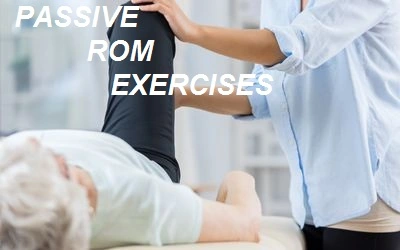Best Sternocleidomastoid Muscle Stretching Exercise
Table of Contents
What is the Sternocleidomastoid stretch?
- Sternocleidomastoid stretch exercise is the best stretching to increase mobility in the neck that assists in reliving neck posture as well as neck pain-related conditions. This exercise is easy to perform at home exercise the patient may start in the early morning.
- Neck muscle tightness is the most common cause of neck pain where SCM is part of the neck muscles group. Regular stretching exercise assists the patient to increase the mobility of the neck.
- The SCM (sternocleidomastoid) is the neck muscle that is commonly related to neck pain & poor hunched posture. The neck stretch is performed to decrease tension in the SCM muscle, increase movement, & decrease neck pain.
- The sternocleidomastoid (SCM) muscle is situated at the base of the skull on both sides of the neck and behind the ears. On either side of the neck, each muscle runs down the front of the neck & divides to attach to the top of the sternum as well as the clavicle. The functions of this muscle are:
- Side-to-side head rotation,
- Side flexion of the neck on both sides,
- Forward bending or even flexion of the neck,
- Assists in breathing as well as respiration,
- Stabilization of the neck from the downward drop helps in swallowing & chewing.
What are the benefits of SCM stretch?
There are some common benefits of SCM stretching:
- Increase the range of motion of the neck
- increase blood circulation in the neck area
- Decrease tension in SCM muscle
- Decrease neck pain
- Decrease stiffness in the neck.
Types of Sternocleidomastoid stretch
There are some traditional methods to perform SCM stretching:
Sternocleidomastoid stretch 1
- How to do this stretching exercise: Take the Sitting position in front of the table.
Keep the chin down & in during the stretch.
Place the right fist on the right side of the chin.
Place the right elbow onto the front of a table.
Put the weight of the head onto the right fist.
Now tilt the head on the right side.
Give pressure to the chin to improve the stretch.
The patient can feel the firm stretch on the left side of the neck.
Hold the stretch for 30 seconds.
Perform on the opposite side.
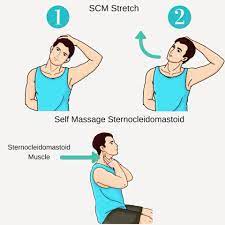
Sternocleidomastoid stretch 2
- How to do the stretch: Tuck the chin inward and downward.
Tilt the head to the right side.
Place the right hand on the left side of the head.
Give the downward pressure.
Gently turn the head to the left side.
The patient can feel the firm stretch in the left Sternocleidomastoid.
Hold the stretch for 30 seconds.
Repeat on the left side.
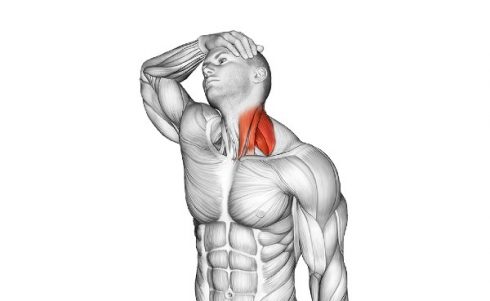
Sternocleidomastoid stretch 3
- How to do the stretch: Put the fingers on top of the left collarbone. Pull the skin down.
Tuck the chin inward as well as downward.
Slowly turn the head towards the left side.
Tilt the head towards the right side.
The patient may feel the stretch on the left Sternocleidomastoid.
Hold the stretch for 30 seconds.
Repeat on the right side.
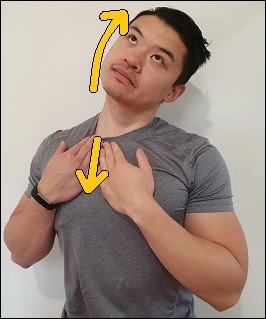
SCM stretch has some variations:
- Chair lean
- Neck elongation
- Head tilts
- Revolved triangle
- Upward plank.
Chair leans
- How to do the stretching exercise: Take the sit on the chair.
- Using the left hand, grab onto the side of a chair.
- The shoulder is completely relaxed.
- Lean on the bed the body fully towards the right.
- Tuck the chin inward & downward.
- Tilt the head towards the right side.
- Put the right hand on the left side of the head
- Give the downward pressure.
- The patient may feel the stretch on the left Sternocleidomastoid.
- Hold the stretch for 30 seconds.
- Repeat on the right side.
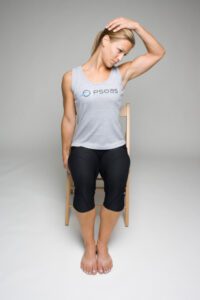
Neck elongation
- How to do this stretching exercise: Tuck the chin inward and downward.
- Slide the head towards the left side.
- Elongate the left side of the neck in an upward direction.
- The patient may feel a stretch on the left side of the neck.
- Change the sides.
- Do 30 repetitions.

Head tilts
- How to do this stretching exercise: Take the Sitting or even standing position facing forward.
- Exhale as you slowly tilt the left ear down toward the shoulder.
- Use the left hand to give gentle pressure to the head.
- Hold it for a few seconds, the patient can feel a stretch on the side of the neck down to the clavicle.
- Inhale & return to the starting position.
- Repeat on the right side.
- Do 10 tilts on both sides.

Revolved Triangle
- How to do this stretching exercise: Stand tall & the feet around 4 feet apart.
- Face the left toes forward as well as the right toes out at a slight angle.
- Square the hips & look forward in the same direction the left toes are pointing.
- Lift both arms upward at either side so they are parallel to the floor.
- Slowly forward bend at the hips, stopping when the upper body is parallel to the floor.
- Bring the right hand to the leg, or the floor as far as you can touch.
- Extend the left arm straight up with the palm facing opposite from the body.
- Turn to look upward towards the left thumb.
- Exhale & turn the neck downward at the floor.
- Inhale as you come back to look upward.
- Keep the other body parts stable & do this neck rotation while staying one minute in this position.
- Do on the other side.
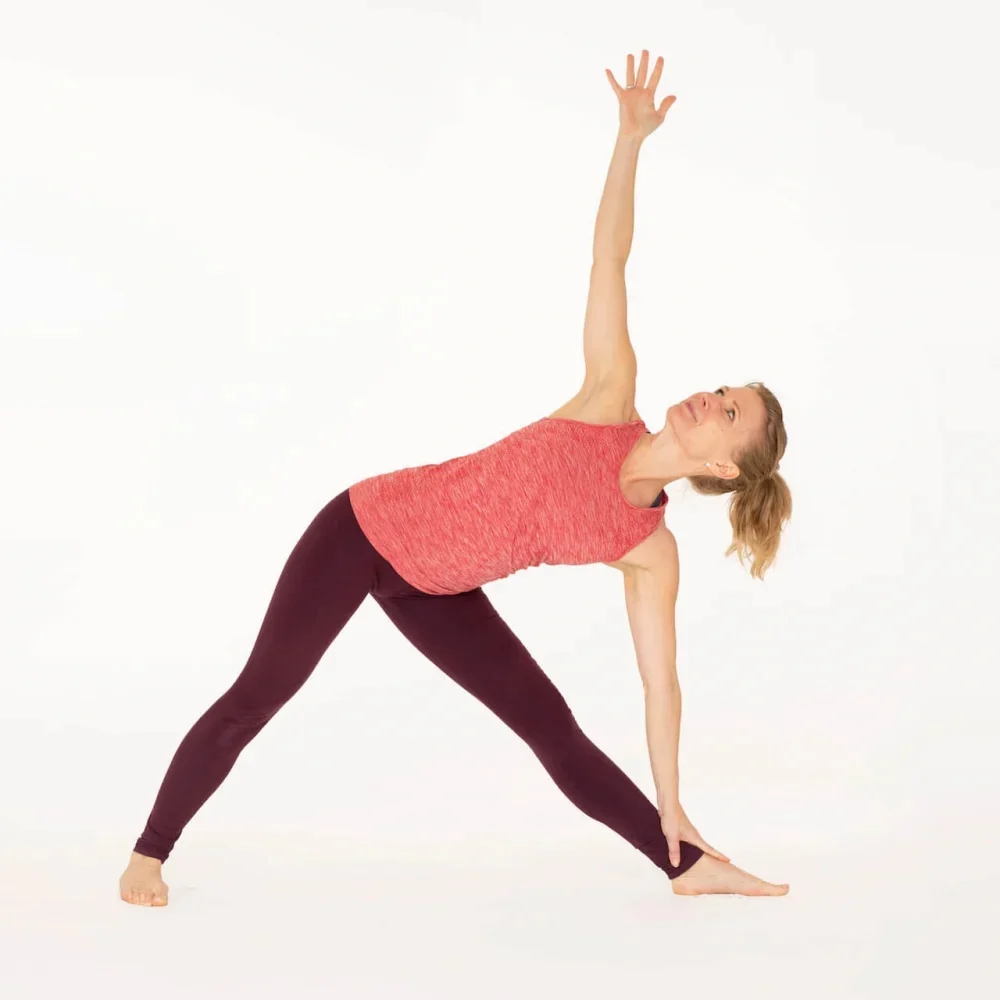
Upward Plank
- In this pose, the patient can hang the head back & down to relieve tension in the neck and the shoulder. If the patient feels uncomfortable then you can use the chair or even the wall for support. Make sure the neck is fully relaxed, otherwise, this compresses the spine. If the patient feels uncomfortable hanging back, he may tuck the chin inward into the chest & lengthen the neck muscles. Focus on occupying the neck muscles without strain injury.
- How to do this stretch: Take the long sitting position.
- Press the palms into the floor by the side of the hips.
- Lift the hips upward & put the feet under the knees.
- Deepen the stretch by straightening the legs.
- Open the chest & the head is dropped backward.
- Hold this position for 30 seconds & perform this 3 times.
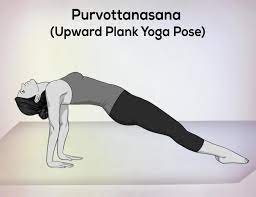
Precautions and safety for Sternocleidomastoid stretch
- Warm-up first: When the patient does stretching, firstly do warm-up. Then start the stretching. This is necessary for good extension & the prevention of injuries.
- Increase stretch gradually: If the patient is a beginner then keep in mind that it does not give extra force while the stretch which gives you an extra or even deep stretch in the starting. Avoid this deep stretch & increase the stretch gradually after some time. Starting with the end or deep stretch puts you in danger or do an injury like a sprain.
- Know the limits: When the patient performs the stretching if the patient feels any pain stop there, that sensation is going too deep into the stretch. Stop the motion immediately when you feel pain. The signs of feeling pain are any joint pain or even clenching of the jaw.
- Avoids dangerous methods: Ballistic stretching is dangerous and includes bouncing the muscles. It causes micro-trauma in the muscles.
- This decreases the flexibility of muscles. Make sure movement should be even & smooth, not bouncy or jagged.
When the patient does not perform SCM stretching?
There are some things when the patient does not perform stretching:
- Do not perform while you have previous injuries.
- Do not perform when you have pain in the neck joint.
- Do not perform while sprain in the muscle.
- Avoid stretching while fracturing of the spine or even around the neck joint such as clavicle fracture.
- If the patient has any neck-related disease, then do not perform the stretch.
- If the patient has any type of nodes in the neck then he should avoid the neck stretching exercise
FAQ
What causes tight sternocleidomastoid?
Some causes of sternocleidomastoid pain include: carrying a heavy object, such as a child or backpack, in an awkward position. poor posture, for example, when a person spends long days hunched over a computer or straining their neck to reach things in the garden.
Can a tight SCM cause tinnitus?
SCM muscle referral pattern: The SCM refers to the ipsilateral ear and posterior auricular region and will often cause sensations of ear fullness and tinnitus. Trigger points in the SCM have been shown to lead to trigger point development in the masseter muscle, making it vital to treat the SCM.
Can tight SCM cause headaches?
Certain muscles in the neck and head, such as the sternocleidomastoid (SCM) can cause headaches when the muscles become tight, overused, and develop trigger points (“knots”).
Can tight neck muscles cause ear fullness?
Neck arthritis, muscle tension, and clenching or grinding of the teeth may cause a plugged feeling in the ear. This is because the jaw joint lies directly in front of the ear, and the base of the skull is directly beneath the ear.
Can you strain the sternocleidomastoid?
The Sternocleidomastoid muscle (SCM) is a bit complex. It can cause neck pain and frequently results in headaches. The sternocleidomastoid muscle can become strained by turning the head to one side when reading in bed, usually towards the light, from looking up or working overhead a lot.

